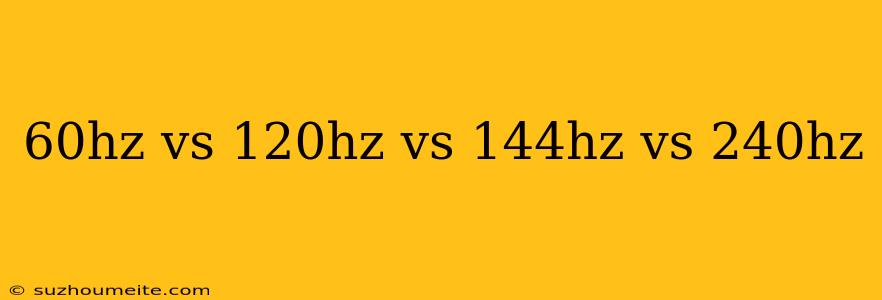Refresh Rate Explained: 60Hz vs 120Hz vs 144Hz vs 240Hz
When it comes to display technology, one of the most important factors to consider is the refresh rate. The refresh rate of a display refers to the number of times the image on the screen is refreshed per second, measured in Hertz (Hz). A higher refresh rate provides a smoother and more responsive visual experience, especially in fast-paced content such as gaming and sports. In this article, we'll explore the differences between 60Hz, 120Hz, 144Hz, and 240Hz refresh rates.
60Hz: The Standard
60Hz is the most common refresh rate found in modern displays, including TVs, monitors, and mobile devices. This refresh rate is sufficient for general use, such as browsing the web, watching movies, and playing casual games. However, it may not be ideal for fast-paced content, as it can lead to screen tearing and stuttering.
Pros:
- Energy-efficient
- Wide compatibility with content
- Cost-effective
Cons:
- May not be suitable for fast-paced content
- Screen tearing and stuttering possible
120Hz: The Step Up
120Hz is a significant upgrade from 60Hz, providing a much smoother visual experience. This refresh rate is commonly found in gaming monitors and high-end TVs. With 120Hz, you can enjoy fast-paced content without Screen tearing and stuttering.
Pros:
- Smoother visuals
- Reduced screen tearing and stuttering
- Ideal for fast-paced content
Cons:
- Requires compatible content and hardware
- Higher power consumption
144Hz: The Gaming Standard
144Hz is a popular refresh rate among gamers, as it provides an even smoother and more responsive experience. This refresh rate is commonly found in gaming monitors and is ideal for fast-paced games.
Pros:
- Extremely smooth visuals
- Ideal for fast-paced games
- Reduced screen tearing and stuttering
Cons:
- Requires high-end hardware to run smoothly
- Limited content availability
240Hz: The Ultimate
240Hz is the highest refresh rate currently available in consumer displays. This refresh rate is typically found in high-end gaming monitors and provides an unparalleled visual experience.
Pros:
- Ultra-smooth visuals
- Ideal for competitive gamers
- Future-proof for upcoming content
Cons:
- Requires extremely high-end hardware to run smoothly
- Very limited content availability
- Higher power consumption
Conclusion
In conclusion, the choice of refresh rate depends on your specific needs and preferences. If you're a casual user, 60Hz may be sufficient. However, if you're a gamer or enjoy fast-paced content, a higher refresh rate such as 120Hz, 144Hz, or 240Hz may be necessary. Keep in mind that a higher refresh rate requires compatible content and hardware, and may consume more power.
